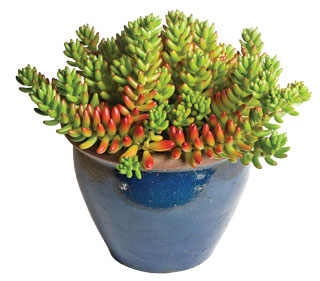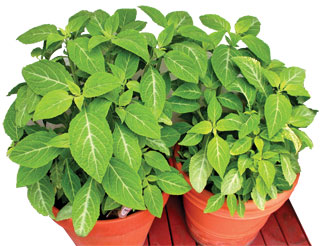Do plants read our emotions?
by Palita Punchibandara SUBASINGHE
“They may be blind, deaf, and dumb in the human sense, but there is
no doubt in my mind that they are extremely sensitive instruments for
measuring man’s emotions” - Marcel Vogel.
The relationship between plants and human beings is not a new
phenomenon. It has been known from periods far back as 4000 BC with
historical evidence of tree worship and gods and goddesses believed to
be dwelling in trees.
Before the rise of Christianity, nature and especially trees were
widely worshipped in many different cultures and times. In the worship
of Apollo, the priests of ancient Greece purified themselves at length
before venturing to a sacred oak grove and calling out questions.

According to legend, the trees answered in human voices. The Celts
and their shamans, the Druids, considered every oak tree to be endowed
with sacred powers.
Even in Christian times, we have such legendary figures as St.
Francis and Hildegard of Bingen speaking of plants and trees as divine
wonders. Over 2500 years ago the Buddha described a forest full of trees
as a peculiar organism of unlimited kindness and benevolence that makes
no demands for its sustenance and extends generously the products of its
life activity.
However, scientific interest on the extraordinary power of plants
began as a result of a casual experiment conducted in 1966 by an
American electronics engineer Cleve Backster. Backster, who was
recognized as America’s foremost lie-detector examiner of the era, was
winding up one of his teaching sessions in his school for polygraph
examiners, teaching the art of lie detection to policemen and security
agents from all over the world when he casually observed the pot plant
in his office.
On an impulse, he decided it would be interesting to measure the time
it took water to go through the root system up to the leaves, using the
polygraph.
Electrodes
He attached the electrodes of his instrument to the leaves of this
plant, a Dracaena (Dracaena massangeana) and started pouring water to
its root area. As the plant sucked up water, the polygraph, to
Backster’s surprise, did not indicate less resistance as might have
expected by the greater electrical conductivity of the wetter plant.
The pen on the graph paper, instead of showing an upward trend, was
treading downwards, with a lot of saw-tooth motion on the tracing.
Having worked with humans, it was known by Backster that such a
reaction was similar to that of a human being experiencing a brief
emotional stimulus.
He repeated the experiment several times using different varieties of
plants and obtained almost the same results.
Research
This led him to conduct further research with plants. To see if a
plant could display memory, a scheme was devised whereby Backster would
identify the secret killer of one of two plants.
He selected six of his students, who, blindfolded, drew from a hat
folded slips of paper on one of which were instructions to remove from
the pot, stamp-on and thoroughly destroy one of two plants in a room.
This was carried out in secret where only the “killer”’ knew of the
secret and only the second plant was a witness. Backster attached a
polygraph to the remaining plant and paraded the students one by one
before the plant. It was no surprise to him, but the plant showed no
reaction to five of the students but showed a violent reaction to the
other every time the “killer” entered the room!
Later on, through further experimentation he discovered that plants
could understand and feel our thoughts instantly. He found out that the
plant felt the mere picking up of a box of matches with the intention of
burning.
Polygraphs
Once when a close friend of Backster entered the room, all his plants
connected to polygraphs went “dead’ showing no response to anything that
he did. Curious to know what could have influenced the plants to behave
this way, he asked his friend whether any part of her work involved
plants.
The friend replied, “I terminate the plants I work with. I put them
in the oven to obtain the dry weight for my analysis.” Forty-five
minutes after the person left, all of Backster’s plants started
responding once again. This experience made him realize that plants
could intentionally be put into a faint or mesmerized by humans.
The research done in 1975 by Dr. Harold E. Puthoff and Randall Fontes
at Stanford Research Institute in Menlo Park, California also supports
the possibility that plants may respond to human consciousness as
contended by Cleve Backster.
This type of severe sensitivity of plants is also pointed out in the
Holy Bible which says “ And on the morrow, when they were come out of
Bethany, he hungered...And seeing a fig tree afar off having leaves, he
came, if haply he might find anything thereon: and when he came to it,
he found nothing but leaves; for it was not the season of figs.
And he answered and said unto it, No man eat fruit from thee
henceforward for ever. And his disciples heard it...And as they passed
by in the morning, they saw the fig tree withered away from the roots”.
 Commenting
on Backsters’ findings, Extra Sensory Perception (ESP) expert Dr. Esser
says, ”When I first heard of Backsters’ experiments I laughed it off but
I have had to eat my words!” Dr, Howard Miller, a cytologist from New
Jersey, believes that a kind of “cellular consciousness” has been
discovered. Commenting
on Backsters’ findings, Extra Sensory Perception (ESP) expert Dr. Esser
says, ”When I first heard of Backsters’ experiments I laughed it off but
I have had to eat my words!” Dr, Howard Miller, a cytologist from New
Jersey, believes that a kind of “cellular consciousness” has been
discovered.
Other scientists feel that Backster has discovered one of the most
potential scientific breakthroughs in history.
In 1956, J.I. Rodale discovered that cuttings grew better if the
mother plant was still alive. It seems as if the mother plant exudes
something or other, which protects and stimulates the cuttings.
When he burned the mother plant, cuttings taken from it thrived far
less well than those from a control group, in which the mother plant
remained undamaged. The distance between the mother plant and cuttings
played little or no part in these experiments.
Psychological
In the United States J.B. Rhine, a well-known personality in the
field of parapsychological experiments and Rev. Franklin Loehr, carried
out tests involving prayer meetings for plants. Various seeds were sown
in two separate groups. Daily prayers were said for one group; the other
had to manage without these good offices.
The results indicated without any doubt, that the plants for which
the prayers were said grew better. Also it was discovered that the
results were equally positive if the prayers were said for the water
used for the plants.
This recalls to the mind of the writer the age-old Sri Lankan
practice of sprinkling “Pirith Pan” or holy water on crops and compounds
to wade off various kinds of disasters.
After a series of experiments with plants Vogel declared
unequivocally that “It is fact: man can and does communicate with plant
life. Plants are living objects, sensitive, rooted in space.
They may be blind, deaf, and dumb in the human sense, but there is no
doubt in my mind that they are extremely sensitive instruments for
measuring man’s emotions.
They radiate energy, forces that are beneficial to man. One can feel
these forces! They feed into one’s own force- field which in turn feeds
back energy to the plant” Closer to home, Dr. T.C. Singh, head of the
Department of Botany at Annamalai University, South of Chennai was
another scientist who was interested in the behaviour of plants.
Classical music
He was successful in demonstrating how plants reacted positively to
classical music played near their vicinity.
He managed to obtain 25-60 % increase in yield from different
varieties of rice by playing Charukesi Raga in the fields.
Perhaps the most interesting and significant of all of Dr Singh’s
findings was that later generations of the seeds of musically stimulated
plants carried on the improved traits of greater size, more leaves, and
other characteristics. Evidently, music had changed the plants’
chromosomes!
Dorothy Retallack of USA, required to devise an experiment for a
college biology class and having heard about the positive effects of
Bach and Beethoven on wheat fields in Canada, sought to determine how
music would affect growth patterns in plants.
Controlled
The plants placed in a controlled environment reacted favourably,
growing faster and more abundantly, to the harmonic strains of the
classical composers, in some cases actually growing in the direction of
the music.
Highly percussive sounds, especially the ‘hard Rock’ of Jimi Hendrix
and the like, stunted them in their growth and they often leaned away
from the hi- fi speaker. The most appealing music, on the other hand,
was not Western, but rather the soothing tones of Ravi Shankar’s Sitar.
In some cases the plants inclined an unprecedented sixty degrees to
the horizontal in an effort to merge with the musical source.
Incidentally, the devastating effect acid rock music has on human beings
was displayed disastrously some years ago, when a student from a leading
Colombo South school who was addicted to this kind of music killed both
his parents.
Going by these facts, the Buddhist religious practice of conducting
“bodhi poojas” (religious offerings and recitations) at the bodhi trees
(Ficus religiosa) may invariably have a scientific meaning. So may be
the significance of the Christmas tree, which the modern society has
relegated only for the purpose of hanging gifts at Christmas time.
Orchids
The writer recalls at this time how a former Sri Lankan beauty queen,
an avid orchid grower, described on TV some years ago, the talking
sessions she had with her orchids.
She was very confident of her successful results in bringing
hard-to-flower orchids to bloom.
All her other orchids perform extraordinarily well after her “loving
conversations” with the plants. Perhaps in this case, the plants reacted
even to the beauty of the caretaker!
It is obvious from the foregoing that there is a strong relationship
or bond between man and plant.
It is well worth that, we, as those interested in nature always be
alive to this fact and treat our plants with a lot of TLC (Tender Loving
Care)! |

